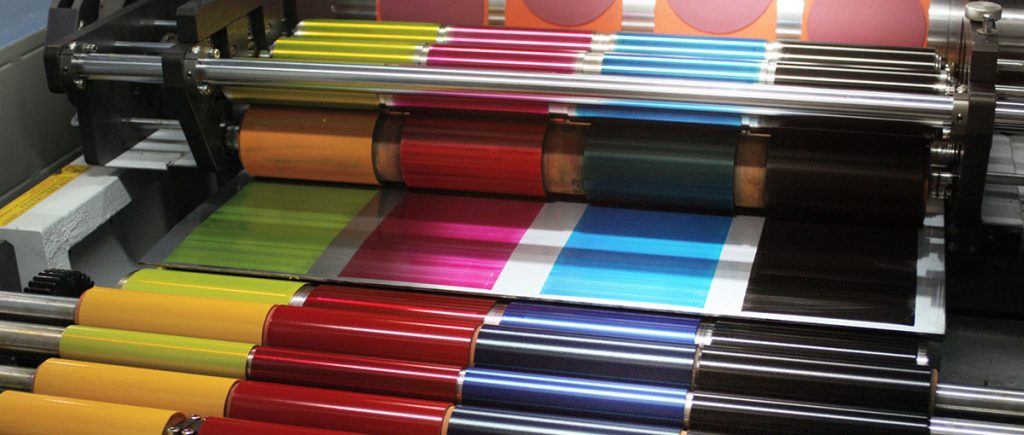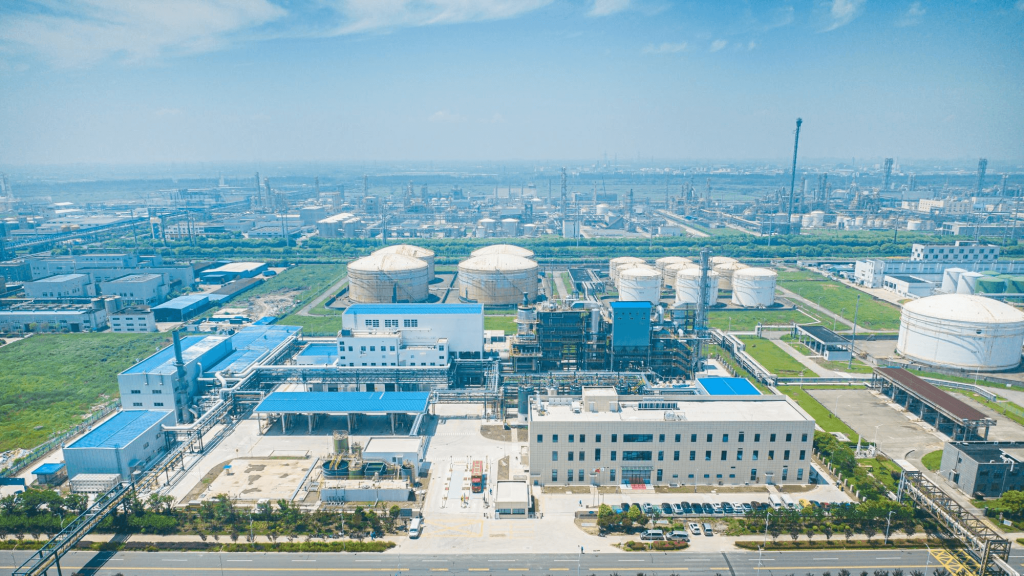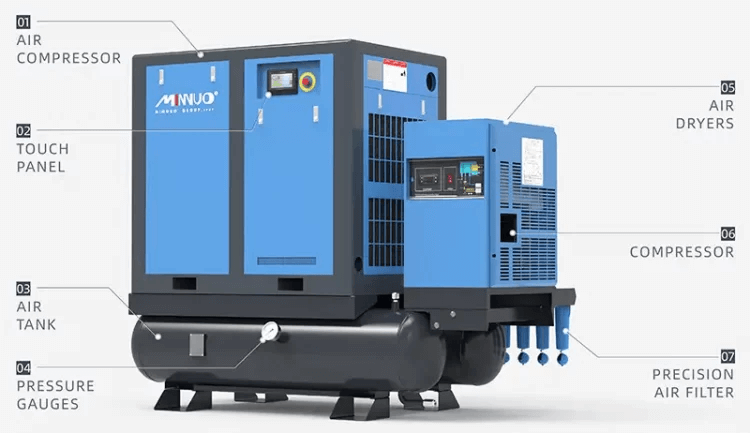If you’re in the printing industry, you know that quality is everything. From the vibrancy of colors to the flawless finish of a package, every detail matters. But there’s one invisible factor that can undermine it all: the compressed air you use.
So, why are oilless air compressors essential for printing? The fundamental reason is to prevent oil contamination from ruining your products. Even trace amounts of oil aerosol or vapor, when carried by compressed air onto paper, ink, or printing plates, can cause color distortion, unexplained spots, and even lead to the rejection of entire production batches. This poses significant quality risks and financial losses. It’s not just a technical requirement; it’s a lifeline for maintaining your business reputation.
To help you fully understand the stakes, let’s walk through the specific domino effects of contamination and clear up what “truly oil-free” really means.
What Happens if Oil Gets into Your Printing Air Supply? The Domino Effect of Contamination
Think of compressed air as the breath of your printing press. If that breath is contaminated, the entire system suffers. Many plant managers don’t realize that the compressed air network is as critical as the ink formulation itself. The following scenarios are not rare “bad luck” but predictable outcomes of a compromised air supply.
1. Color Distortion and Ink Rejection: The Silent Quality Killer
The chemistry between ink and substrate is delicate. Oil introduced via compressed air acts as a contaminant that breaks down the bonding agents in the ink. This isn’t always a dramatic failure; often, it’s a gradual degradation. On press, this manifests as ink misting – a fine, wasteful spray of ink particles in the air around the press – and more critically, ink rejection on the paper itself. You’ll see muted, washed-out colors where vibrancy is crucial, and blurred edges on text and fine lines that make the entire product look unprofessional. For a printer producing high-value marketing collateral or luxury packaging, a single batch with these issues can damage a hard-earned reputation with a key client.
2. Unwanted Spots and Ghosting: The Costly Production Nightmare
Imagine a high-speed web press running a 50,000-copy job. Microscopic oil droplets, invisible to the naked eye, are traveling through your air lines. At the point of use – perhaps a pneumatic jet that cleans the sheet before printing – these droplets are atomized into a fine mist that settles on the paper. The result? Tiny, random oil spots that appear as glossy or repelled areas on the final product. The nightmare begins in the finishing department, where inspectors must scrap entire sections of the run. The cost isn’t just in the paper and ink wasted; it’s in the lost press time, the overtime labor to rerun the job, and the potential penalty for missing a delivery deadline.
3. Weakened Structural Integrity in Packaging: A Failure in the Field
This is a critical, often overlooked issue for packaging printers. Processes like lamination, coating, and sealing rely on perfect molecular-level adhesion between layers. An invisible, microscopic film of oil on the cardboard or plastic film acts as a powerful release agent. This can cause the layers of a food pouch to delaminate, a blister pack to separate, or a label to peel off a bottle on the store shelf. Such a failure is no longer just a quality control issue; it becomes a product recall scenario, with devastating financial and legal repercussions for your client – and by extension, for your business relationship.
4. The Silent, Accelerated Wear on Your Valuable Capital Equipment
The damage isn’t limited to your products; it’s also happening inside your expensive machinery. Oil carried in the air stream slowly coats and clogs the intricate pneumatic components that control everything from paper feeding to ink roller engagement. It mixes with ever-present paper dust to form a sticky, abrasive sludge. This grime accelerates wear in precision cylinders, solenoid valves, and nozzles, leading to inconsistent operation, more frequent breakdowns, and unplanned downtime. The cost of replacing these components and the lost production time can quickly surpass the price difference between an oil-lubricated and an oil-free system. Investing in a properly configured compressed air system is not an expense; it’s insurance for your entire production line.
What Does “Truly Oil-Free” Really Mean for a Printer? Beyond the Marketing Hype
It’s not enough to just buy a compressor labeled “oil-free”. The entire system, from the compressor’s internal mechanism to the air reaching your machine, must be engineered to deliver and maintain absolute purity.
1. The Gold Standard: Demystifying ISO 8573-1 Class 0 Certification
Beware of vague marketing terms like “technically oil-free.” The only globally recognized, verifiable guarantee of oil-free air is the ISO 8573-1 Class 0 certification. This standard is rigorous. It doesn’t just mean “low oil content”; it signifies that the compressed air is certified to contain zero oil content—in aerosol, liquid, or vapor form—at the point of discharge from the compressor. When a manufacturer claims Class 0, they are staking their reputation on a measurable, international standard. Always insist on seeing this certification for the specific model you are considering.
2. The Invisible Enemy: Why Moisture Control is Non-Negotiable
Even with a perfectly oil-free compressor, atmospheric humidity is drawn in and compressed. This water vapor will condense as the air cools in your pipelines, creating liquid water. In printing, this moisture can cause paper to warp and curl, leading to misregistration and jams. It can also dilute ink at the microscopic level, affecting drying times and color density. Therefore, a high-efficiency compressed air dryer (refrigerated for most applications, desiccant for very dry air requirements) is a non-negotiable partner to your compressor, ensuring the air is not just oil-free, but also dry.
3. The Final Barrier: The Critical Role of Particulate Filtration
Dust, pollen, and other airborne particles are always present in the intake air. Even in an oilless system, these particulates can be compressed and carried down the line. A multi-stage filtration system installed after the compressor and dryer is essential. This final “polishing” stage removes any remaining solid contaminants down to a specified micron size, ensuring that the air touching your products is as impeccably clean as the environment in your pressroom demands. This protects both your print jobs and the sensitive pneumatic controls of your machinery.
Match the suitable oil-free air compressor equipment for your business
The good news is that oil-free technology isn’t one-size-fits-all. Different types of compressors are designed to meet specific operational demands and budgets, ensuring you can find an efficient solution for your shop.
For High-Volume, Continuous Production: The Reliability of Oil-Free Screw Compressors
For large-scale offset, flexographic, or gravure presses that run for 16-24 hours a day, the oil-free screw compressor is the industry’s workhorse. Its design, based on two precision-meshing rotors, provides a continuous, pulsation-free supply of high-volume, Class 0 air. This stability is crucial for maintaining perfect registration and consistent color density in long print runs. Beyond reliability, modern screw compressors are also engineered for exceptional energy efficiency, significantly reducing your largest operational cost—electricity—over the compressor’s lifetime.
For Quiet, Compact Operations: The Discreet Power of Oil-Free Scroll Compressors
In environments like in-plant printing departments or digital print shops, space is limited and noise is a major concern. The oil-free scroll compressor, with its few moving parts and orbiting scroll mechanism, operates at a remarkably low decibel level. Its compact footprint and quiet operation make it ideal for powering wide-format printers and digital presses without disrupting the creative or office workspace.
For Low-Cost, Auxiliary Applications: The Practicality of Oil-Free Piston Compressors
Not every air need in a print shop is for the press itself. For non-critical, intermittent tasks like powering small desktop printers, actuating jigs, or cleaning, the economical oil-free piston compressor provides a simple and effective solution. It’s a practical choice for ensuring clean air in auxiliary applications, especially when the primary printing process is already safeguarded by a central oil-free system.
FAQ: Making the Confident Choice for Your Printing Business
Q: My printing business is small. Is an oil-free compressor really necessary, and which type should I consider?
A: The need for oil-free air is defined by the sensitivity of your printing process and the quality standards of your final product, not solely by the size of your operation. If ink contamination, spots, or adhesion issues would compromise your work and lead to financial loss or client dissatisfaction, then the investment is justified. For smaller operations, the key is to assess the risk and choose a compressor type (like a scroll or piston) that matches your air volume demands and budget.
Q: I’ve heard oil-free compressors are more expensive to maintain. Is this true?
A: This is a common misconception. While the upfront investment can be higher, oil-free compressors eliminate significant ongoing costs: you never need to buy expensive compressor oil, replace oil filters, or pay for the hazardous waste disposal of used oil. When you calculate the Total Cost of Ownership (TCO) over a 5-10 year period, an oil-free system often proves more economical. Most importantly, it eliminates the catastrophic, unbudgeted cost of a spoiled production run.
Conclusion: Secure Your Print Quality from the Ground Up
In the precision-driven world of printing, where margins are tight and reputation is everything, compromising on your foundational utilities is a risk you cannot afford. Your compressed air supply is not a supporting actor; it is a key determinant of your final product’s quality. An oil-free air compressor is a strategic investment in your product consistency, your operational reliability, and your company’s hard-earned reputation.
By understanding the severe, multi-faceted risks of oil contamination, you can make an informed choice to secure the pure, reliable air that is the invisible yet essential ingredient behind every successful print job.
Breathe easy. Ensure your quality is never compromised.
A Note from Us: Navigating the different types of oil-free compressors can be complex. At Minnuo Group, we’ve dedicated ourselves to this technology and offer a comprehensive range—from robust screw compressors and quiet scroll compressors to economical piston models—to meet any printing facility’s needs. If you’re evaluating your options, we’re here to provide the technical data and support to help you make the right choice.
Contact us today for a professional, no-obligation assessment of your air needs.






 Email
Email sales:+86 15366749631
sales:+86 15366749631

